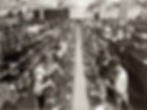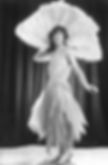Jazz Age Series: New Women
- Aylin Usta
- Mar 21, 2022
- 6 min read
Updated: Sep 21, 2024
Foreword
One of the most important eras of American history, the Jazz Age, started after World War I and ended with the outbreak of the Great Depression in 1929. This era offered new images and terms of both literature and culture in a wide spectrum. In this period, the United States went through a huge transition and began to prosper in music, literature, economy, policy, and technology. In 'The Roaring Twenties', known also as 'the Golden Age', divergent cultures gathered in one pot and shaped the decade with their own unique characteristics. This age changed American culture dramatically and, still affects it today. Therefore, it is crucial to gain knowledge of the Jazz Age in order to better understand American culture and literature. In each article, the Jazz age series will cover the stories of people from different backgrounds to enlarge readers' perspectives.
Jazz Age Series is mainly divided into five chapters including:
Warning: There is offensive terminology in this article, but it is repeated solely for historical purposes.
Jazz Age Series: New Women
With the impact of WWI, women of the United States brought to the surface different ideas that had never been mentioned before. They started to question women's role in society. Especially pondering how their rights were being destroyed by patriarchal power. The rising wealth of individuals led to an emergence of society parties where women gathered and discussed issues such as their right to vote, jobs of women, their legitimate rights and their status in the workplace. The birth of New Women appeared with the contribution of these interrogations. Until that point in the 1920s, women's roles were reduced to raising children, doing housework, caring for family, cooking for their children and husbands. As William E. Leuchtenburg mentioned:
The new women wanted the same freedom of movement that men had and the same economic and political rights. By the end of the 1920’s she had come a long way. Before the war, a lady did not set foot in a saloon; after the war, she entered a speakeasy as thoughtlessly as she would go into a railroad station… In the business and political worlds, women competed with men; in marriage, they moved toward a contractual role… Sexual independence was merely the most sensational aspect of the generally altered status of women (Leuchtenburg,159).

[Members of the Royal Order of Flappers in 1922. When they announced the formation of their organization, they were deluged with letters and telephone calls from men wanting to make acquaintances with its members.)
Before this age, there was no place for women to display their true desires. These dogmatic Victorian ideas made women silent against American society and policy. These traditional images of women dominated male perception and, restricted women from going further in society. They lacked a political, educational, social world before the New Women image. However, during WWI women proved that they were capable of doing the same job as men; because of the war there was an open position in the workplace for women. They took over men's jobs and showed that they could cope in this patriarchal work society, and gain the same status just like men had.

[Atwater Kent radio set assembly, Philadelphia, 1925]
The term ''flappers'' came to America in the 1920s. Generally, the term was used to describe a white woman. As Antonio Rubio and Isabel Conesa described in The Role of Women in the Roaring Twenties: ‘’She wore lipstick and rouge, she cut her hair into a short, blunt style called a bob and plucked her eyebrows. She drove cars, went to movies, and she drank. Fashions were lightweight and comfortable’’ (Rubio, Conesa, 5). These women started to enjoy parties, smoking, and dancing. Especially the dance known as the Charleston which became popular among them. The rhythm of the jazz poured into their souls and they saw themselves as the modern image of women. Furthermore, with their rejection of household work, the sparks of feminism emerged as they opposed old fashioned mindset. They asserted that the embodiment of liberation was a freedom of choice in dress and behaviour. Therefore, they put on shorter dresses, preferred short hair, and exhibited behaviour that was not seen before. Different from their mothers who dressed in conservative clothes with dark and covered motifs, the flappers of the 1920s decisively chose to show themselves with the help of clothing.

[Four women lined up along a wall, chugging bottles of alcohol. Circa 1925.]

[A flapper in London models an evening frock of lilac tulle with a beaded tunic. 1922.]
In the 1920s there was a significant transition in terms of the image of American women, it wasn't restricted only to the image of an extravagant white women. Interpreting these ''flapper images'' as a symbol of New Women could be misleading, because they were also associated with a materialistic and consumerist image. That conclusion was not entirely debated in the 1920s women's movement. No matter how these flappers enjoyed their taste of freedom, there were myriad struggles in society. These feminist supporters not only fought against patriarchal power but also tried to bring awareness to women.

[Afternoon Dresses]
Compared to the white female struggle, black women encountered more complicated situations. They were not only fighting to get their rights as women but also racism was a huge impediment they had to surpass. Furthermore, they strived to destroy the black bourgeoisie's strict ideas which were related to their roles in the black community. As A. B. Christa Schwarz, underlined in The Cambridge Companion to the Harlem Renaissance:
The black bourgeoisie strove to control black women’s sexual image – particularly as thousands of single black female migrants poured into the northern cities. Black women were ideally positioned as ‘‘mothers of the race,’’ responsible for the future of black America (Schwarz, 143).
Being stuck in those norms made things harder for black women. They believed that their existence was more than these family obligations. Thus, they founded organizations to reveal their actual position, also to challenge racism and other issues that they faced.

[Black female models 1942]
The 1920s was a crucial point for women because, especially after WWI, the suffrage movement gained dynamism. On 26 August 1920, the 19th Amendment passed into law, women obtained the right to vote in elections for the first time in American history. That was an important step for women's history in the United States because it paved the way for other rights like a college education, equal conditions in the workplace and so on. Although it was a challenge to destroy the strict mindset towards gender roles in society, a movement gained its power by taking suffrage. As Rebecca J. Mead underlined in The Woman Suffrage Movement in the United States: '' Woman suffrage challenged the legal principle of coverture, which subsumed a married woman’s political and economic identity into her husband’s; it also challenged dominant gender roles that confined women to the domestic sphere'' (Mead,1). Yet, the right to vote was not valid for all women. So, acquiring suffrage did not provide promise for all American women in a full equal way. There was no law to give Black women the right to vote in the southern states. They were neglected by society not only because of their gender but also because of their race. The white women community disregarded Black women's incidents in terms of their objectives. The Voting Rights Act of 1965 enabled black women to vote. In this way, black women had a role in the gender issues more actively to destroy inequality between white and black women.

[Black Women in Uniform Marching in Parade]
To sum up, women fought to obtain social, economic, and educational positions within the 1920s movement. They wanted to gain political rights in order to demonstrate their abilities in congress and elections. They proved that their identity was not limited to the constructed norms. As Einav Rabinovitch-Fox emphasizes in New Women in Early 20th-Century America:
The New Woman could be a suffragist or a flapper, a Gibson Girl or a settlement house worker, an actress or a factory laborer, and oftentimes these images and meanings overlapped, allowing women to adopt some characteristics while renouncing others (Rabinovitch-Fox, 2).
The new image of women could be related to any description that they wanted to fit in. It was not restricted to one role. They could create any modern image by dressing, working, educating, or housekeeping. And, this image was not only associated with being a mom or wife, it was more than this. They supported the idea that they could obtain any image that suited their preference. Hence, this era could be counted as one of the most important in American history for women obtaining more rights.
References
Leuchtenburg, William E. The Perils of Prosperity, 1914-1932. University of Chicago Press; 2nd edition Sep.15, 1993.
Mead, Rebecca J. “The Woman Suffrage Movement in the United States.” Oxford Research Encyclopedia of American History, 28 Mar. 2018, pp. 1–32., doi:10.1093/acrefore/9780199329175.013.17.
Rabinovitch-Fox, Einav. “New Women in Early 20th-Century America.” Oxford Research Encyclopedia of American History, 22 Aug. 2017, pp. 1–38., doi:10.1093/acrefore/9780199329175.013.427.
Rubio, Antonio Daniel Juan, and Conesa, Isabel María García. “The Role of Women in the Roaring Twenties”. https://repositorio.upct.es/bitstream/handle/10317/2192/rwr.pdf . Accessed 14 Mar. 2022.
Schwarz, A . B. Christa. “Transgressive Sexuality and the Harlem Renaissance.” The Cambridge Companion to the Harlem Renaissance, edited by George Hutchinson, Cambridge University Press, 2007, pp. 143–143.
Image References
A flapper in London. [Photography]. https://allthatsinteresting.com/flappers-1920s#11
Afternoon Dresses. [Photography]. https://vintagedancer.com/1920s/1920s-black-fashion-african-american-clothing-photos/
Atwater Kent radio set assembly, Philadelphia, 1925. [Photography]. https://imgur.com/r/HistoryPorn/kzwPIr1
Black female models 1942. [Photography].https://www.etsy.com/listing/1142893454/african-american-8-x-10-photo-black epik=dj0yJnU9c1RneDQ5N3hGbmVPanpNNmZZamFIOC0ya1N2eVR5RFkmcD0wJm49NGtGX3ZOVXVHVjNXQlhpX21BR2NTUSZ0PUFBQUFBR0kxNHRN
Black Women in Uniform Marching in Parade. https://www.theatlantic.com/ideas/archive/2020/06/pioneering-black-women-who-paved-way-moment/612838/
Four Women. [Photography]. https://allthatsinteresting.com/flappers-1920s#5
Members of the Royal Order of Flappers. [Photography]. https://allthatsinteresting.com/flappers-1920s#19






